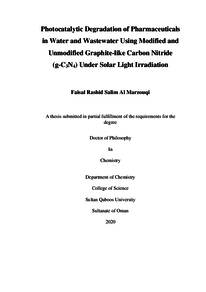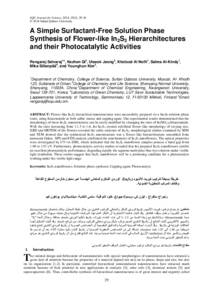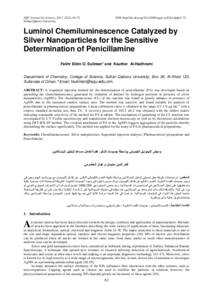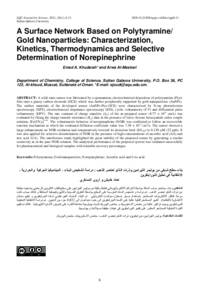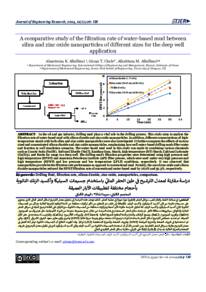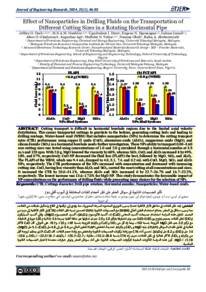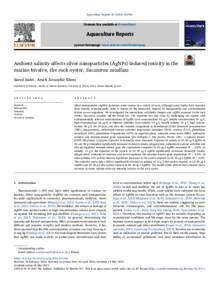Document
Photocatalytic degradation of pharmaceuticals in water and wastewater using modified and unmodified graphite-like carbon nitride (g-C3N4) under solar light irradiation.
Publisher
Sultan Qaboos University.
Gregorian
2020
Language
English
English abstract
Due to continuous global energy demand and industrial development,
considerable interest has been attended towards the health impacts of organic and
inorganic pollutants in the environment. Such pollutants can severely damage our
aquatic environment. The contamination level increases rapidly every year due to
human activities, industrial development and lack of efficient water treatment
technology. So far, several studies have shown the presence of organic pollutants in
treated water. Meanwhile, some other studies focused on the possible pathways for
those pollutants to reach freshwater in the environment. Emerging pollutants can be
found in the environment at µg/L to ng/L levels. In general, this includes chemicals
such as pharmaceutical compounds and personal care products, as well as endocrinedisrupting chemicals. Moreover, the presence of some pharmaceutical compounds is
known for causing a serious effect on the health of living organisms along with the
formation of the drug's resistant bacteria. Therefore, it is necessary to design and
synthesize of artificial photocatalysts with high activities.
Implementation of photocatalytic properties of semiconductor materials has
shown potential method to purify wastewaters. This includes materials like metal
oxides, metal sulphides and oxygen nitrides. Recently, carbon based materials like
graphitic carbon nitride (g-C3N4) is found to show promising photocatalytic properties
due to conduction of higher electrical charges, suitable redox potential, band structure
located in the visible light region (band gap 2.7 eV), thermal and chemical stability,
and the simplicity of production that allows it for large-scale production from low-cost
precursors. However, the photocatalytic efficiency of the pure g-C3N4 is limited by the
high recombination rate of the photo-induced electron-hole pairs. The aim of this thesis
is to design and fabricate pure and modified carbon nitride photocatalytical materials
by direct thermal heating and microwave assisted technique and to study the
photocatalytic degradation of pharmaceuticals under visible light irradiation.
First, several nitrogen-rich precursors were used to prepare carbon nitride
materials and after a thorough systematic analysis, few precursors were chosen and
studied for large scale, economic and safe production. The synthesized materials were
characterized for structure, morphology, surface area, optical and electrochemical
properties. The properties were compared with reported results and their variations are
interpreted. The photocatalytic efficiency of the synthesized materials were studied for
degradation of pharmaceutical residues. The results reveal that the g-C3N4 sample
prepared from melamine gives higher yield and photocatalytic efficiency, which has
been justified by suitable degradation mechanism.
After obtaining the g-C3N4 bulk materials, a thermal oxidation process has been
used to produce the g-C3N4 nanosheets. Two heating steps method were operated on
the g-C3N4 bulk. The bulk g-C3N4 materials were converted to nanosheets by two
thermal oxidation processes operated in a semi-closed system under ambient pressure.
The transformation of the bulk materials to nanosheets was confirmed by scanning
vii
electron microscopy (SEM), energy-dispersive X-ray spectroscopy (EDX), X-ray
diffraction (XRD), X-ray photoelectron spectroscopy (XPS), photoluminescence (PL),
Fourier-transform infrared spectroscopy (FTIR), UV-vis diffuse reflectance
spectroscopy (UV-vis DRS), Bruneaur Emmett Teller (BET) and particle size analysis.
The photocatalytic degradation of pharmaceuticals by the nanosheet samples were
found to be much faster than the bulk materials.
The g-C3N4 nanosheets were coupled with CdS and BiOCl nanoparticles by
using microwave-assisted method to obtain rapidly uniform sized CdS/g-C3N4 and
BiOCl/g-C3N4 heterojunction nanosheets. The composites were studied by using
scanning electron microscopy (SEM), energy-dispersive X-ray spectroscopy (EDX),
X-ray diffraction (XRD), photoluminescence (PL), Lifetime decay measurement, and
photocurrent. The photocatalytic degradations of pharmaceuticals by the synthesized
materials were studied.
Moreover, a direct thermal method is used to couple Graphene (Gr) nanosheet
with g-C3N4 nanosheet and characterized by using scanning electron microscopy
(SEM), energy-dispersive X-ray spectroscopy (EDX), X-ray diffraction (XRD),
Photoluminescence (PL), Lifetime decay measurement, and photocurrent. The
prepared samples were tested for photocatalytic degradation of pharmaceutical
pollutants.
The results in this thesis clearly confirm that the photocatalytic activity of
modified carbon nitride (g-C3N4) based materials can efficiently be enhanced by
converting the bulk material to nanosheeet and coupling with CdS, BiOCl
nanoparticles and graphene nanosheet. The increase in photocatalytic activity can be
described due to separation of the photo-induced electron-hole pairs and the increase
of the active sites for the photocatalytic reaction. The study further shows that the
modified samples can be used to treat wastewater contaminated by pharmaceuticals
under visible and solar irradiation
Member of
Resource URL
Arabic abstract
بسبب الطلب العالمي المستمر على الطاقة والتنمية الصناعية، تم الاهتمام بشكل كبير بالتأثيرات الصحية للملوثات العضوية وغير العضوية في البيئة.ومن المعلوم أنه يمكن لهذه الملوثات أن تضر بيئتنا المائية بشدة , حيث يزداد مستوى التلوث بسرعة كل عام بسبب الانشطة البشرية والتنمية الصناعية ونقص كفاءة تكنولوجيا معالجة المياه الموجودة حاليا. وقد أظهرت العديد من الدراسات حتى الان وجود ملوثات عضوية في المياه المعالجة. من ناحية أخرى ركزت بعض الدراسات على المسارات المحتملة لتلك الملوثات للوصول إلى المياه العذبة في البيئة. الا أنه تم العثور على الملوثات الناشئة في البيئة عند مستويات مرتفعة بشكل عام، وتشمل تلك مواد الكيميائية المركبات الصيدلانية ومنتجات العناية الشخصية، بالاضافة إلى المواد الكيميائية المعطلة للغدد الصماء. علاوة على ذلك، من المعروف أن وجود بعض المركبات الصيدلانية يسبب تأثيرا خطيرا على صحة الكائنات الحية إلى جانب أنه يعمل على تحفيز تكوين البكتيريا المقاومة للعقار. لذلك، من الضروري تصميم وتركيب المحفزات الضوئية الاصطناعية للتخلص من هذه المركبات. أظهرت الخصائص التحفيزية لمواد أشباه الموصلات أظهرت طريقة محتملة لتنقية مياه الصرف. وهذا يشمل أكاسيد المعادن والكبريتيدات المعدنية. وفي الاونة الاخيرة، تم العثور على المواد القائمة على الكربون مثل الكربون المنترد الذي أظهر خصائص تحفيزية واعدة بسبب توصيل شحنات كهربائية أعلى، وإمكانية الاكسدة المناسبة، والنطاق التحفيزي الموجود في منطقة الضوء المرئ، بالاضافة لاستقرار الكيميائي وسهولة الانتاج التي تسمح بتصنيع المواد على نطاق واسع ومن مكونات منخفضة التكلفة. يجدر هنا الاشارة، الى أنه تم استخدام العديد من المركبات الغنية بالنيتروجين إلعداد مواد نيتريد الكربون وبعد تحليل منهجي شامل، تم اختيار ودراسة عدد قليل من المركبات لإلنتاج اقتصادي. كما تمت مقارنة الخصائص مع النتائج المحضرة وتم تفسير اختالفاتها. وأيضا تمت دراسة الكفاءة التحفيزية الضوئية للمواد المركبة لتحلل نفايات الادوية. أظهرت النتائج ان العينة المحضرة من الميلامين تعطي إنتاجية وكفاءة أعلى، والتي تم تبرير اسبابها بآلية مناسبة. بعد تحضير المحفزات الضوئية من الكربون المنترد تم دمج شرائج الكربون المنترد النانومترية مع جسيمات نانومترية أخرى لرفع كفاءتها باستخدام طريقة الميكروويف للحصول على بحجم موحد ونوى متجانسة. كما تمت دراسة خصائص هذه المركبات باستخدام اجهزه متطورة عالوة على ذلك، يتم استخدام طريقة حرارية مباشرة إلقران شرائج الجرافين مع شرائح الكربون المنترد حيث تم اختبار العينات المحضرة للتكسير التحفيزي الضوئي للملوثات الصيدلانية. تؤكد النتائج الواردة في هذه الاطروحة بوضوح أن النشاط التحفيزي للمواد النتريدية الكربونية المعدلة يمكن تعزيزه بكفاءة عن طريق تحويلها إلى شرائج نانومترية.
Category
Theses and Dissertations

